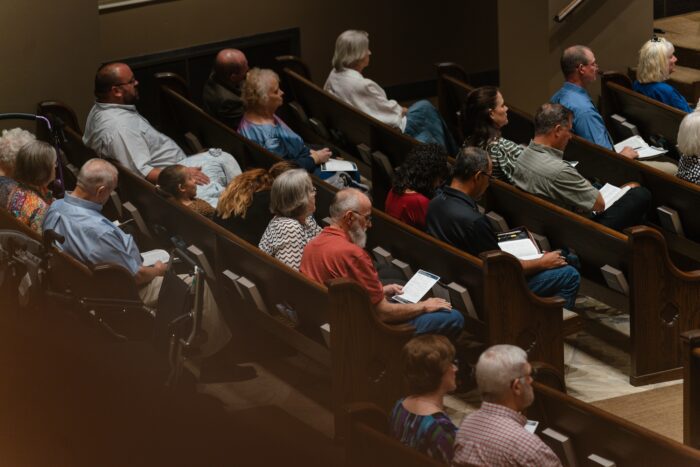Automatic doors, elevators, ramps, and even hearing loops have become common in public buildings in the United States. The Americans with Disabilities Act (ADA) has created and is still creating access to public spaces. Even the church, at least our buildings, is becoming more and more accessible to people with disabilities. Accessibility is a good thing as it means more people can have a meaningful participation in our ministries. The more accessible the church, the more opportunities we have to make disciples in our communities.
The number of people in America with disabilities is larger than you probably think. Studies indicate that 12.9 percent of students in American public schools receive some type of special education services due to a disability.[1] Census data revealed in 2010, over 56 million people in the United States with a disability living in non-institutionalized settings. Nearly 20% of our population has a disability.[2] This data means every church building is located near someone with a disability and every church member lives near someone with a disability.
The community of persons with disabilities is less likely to be engaged in a faith community than their typical peers. A research project examined the community experiences of 12,000 adults with developmental disabilities.[3] Only 48 percent of those adults reported attending religious services at least one time in the prior month. Another survey disclosed that 57 percent of adults without disabilities attend church monthly as compared to 45 percent of adults with a disability.[4] Even though people with disabilities are living in our neighborhoods, shopping the same grocery stores, using the same banks and gas stations, they are less likely to be attending church.
There is a significant number of people who are not being reached by the church with the gospel and a large gap between those who are abled and those with disabilities in their participation in the faith community. A glance at most church auditoriums on Sunday morning will reveal a noticeable absence of people with disabilities serving the church. The statistical gap in church attendance is dwarfed by the visible gap in ministry leadership and service. Where are those with disabilities and why aren’t they serving the church?
Churches often place an emphasis on ministry to persons with disabilities. This is reflected in numerous denominational resolutions and position statements as well as in the growing number of conference gatherings and workshops addressing faith and disability.[5] While hospitality may be increasing in the church, inclusion is not necessarily growing.[6] Churches lag behind the broader culture in terms of inclusion, specifically in engaging individuals with disabilities as co-laborers on leadership and ministry service teams.
Church members can learn and grow as they serve the church in various capacities. Yet this opportunity is often denied to people with disabilities. Leading and serving give church members opportunities to grow spiritually, deepen their relationship with God, enjoy fellowship, and develop friendships.[7] Only parishioners who are physically and cognitively abled get to experience this growth as the focus of ministry is generally to those with disabilities and rarely with them.
Churches may feel unprepared to provide appropriate hospitality and discipleship opportunities to guests with disabilities. A church often has no plan or strategy to disciple people with developmental disabilities. Thus, people with disabilities remain on the margin of the church even when they are present in the congregation.[8] The accommodations needed for a person with a disability to be a contributor to the faith community are not made. Potentially valuable contributors and their contributions are simply overlooked or not desired. Marginalization is the experience of many individuals with disabilities who have found ways to partake and create within the greater culture and society but still find themselves ostracized when they come to church.
Society today is characterized by inclusive schools, inclusive neighborhoods, and inclusive workplaces, yet the church seems to have neglected to look beyond the disability to see the abilities and contributions that this under-utilized demographic might possess[9]. Many people with disabilities have extraordinary gifts that could be utilized within and for the Body of Christ. Unfortunately, the unique and exceptional gifts possessed by those with special needs can be hidden under the cloak of their disability, and therefore they are often absent from serving in any public ministry role. If members of the church are not exercising their spiritual gifts for ministry, then the church may not grow to spiritual maturity (Eph 4:7-16).[10]
Biblical Considerations
Three biblical concepts or doctrines help to advance the argument for inclusion in the church. The doctrines of imago Dei, spiritual gifts, and the Great Commission are properly understood to include people with disabilities.
Imago Dei, the Image of God
The creation account from Genesis clearly states man is created in the likeness and image of God (Gen 1:26-27). The concept of mankind being created in the image and likeness of God is not limited to the Old Testament as Paul and James both reaffirm this truth in the New Testament. Paul admonishes the church at Ephesus to “put on the new self, created after the likeness of God in true righteousness and holiness” (Eph 4:24). In writing about the destructive power of the tongue, James states, “With it we curse people who are made in the likeness of God” (Jas 3:9).
What does it mean to bear God’s image? Wayne Grudem posits it is impossible to fully grasp what it means to be created in the image of God, stating, “A full understanding of man’s likeness to God would require a full understanding of who God is in his being and in his actions and a full understanding of who man is and what he does.”[11] Grudem further articulates his position concerning individuals with disabilities being fellow image bearers in the following way:
Every single human being, no matter how much the image of God is marred by sin, or illness, or weakness, or age, or any other disability, still has the status of being in God’s image and therefore must be treated with the dignity and respect that is due to God’s image-bearer. This has profound implications for our conduct toward others. It means that people of every race deserve equal dignity and rights. It means that elderly people, those seriously ill, the mentally retarded, and children yet unborn, deserve full protection and honor as human beings.[12]
As fellow image-bearers, individuals with disabilities have an intrinsic value and worth that cannot be denied or excluded from the church. Human value comes from the fact that people are created in the image and likeness of God, not in the possession of any ability. Thus, any marginalization based upon the perception of the evidence of the image of God in the individual is taking an ableist or discriminatory position.
Spiritual Gifts
The second biblical doctrine supporting the argument for the inclusion of individuals with special needs within the ministries of the church is the doctrine of spiritual gifts. In writing to the church at Corinth, Paul states,
Now there are varieties of gifts, but the same Spirit; and there are varieties of service, but the same Lord; and there are varieties of activities but it is the same God who empowers them all in everyone. To each is given a manifestation of the Spirit for the common good. (1 Cor 12:4-7)
To the church in Rome, Paul teaches,
For by the grace given to me I say to everyone among you not to think more highly of himself than he ought to think, but to think with sober judgment, each according to the measure of faith that God has assigned . . . having gifts that differ according to the grace given us, let us use them. (Rom 12:3, 6)
And to the church at Ephesus Paul writes, “But grace was given to each one of us according to the measure of Christ’s gift” (Eph 4:7). Paul is writing specifically to the church about each of the members being gifted for ministry. The clear implication is that every regenerate person has some spiritual gift to contribute to the church.
Each believer is uniquely gifted to serve the church. The truth presented by the apostle Paul is that the Holy Spirit gives gifts to regenerate persons to build up the church. The gifts given are not based on the capacities or abilities of the person, the gifts are based solely on the choice and power of the giver, the Holy Spirit. Spiritual gifts are given to every believer for the purpose of fulfilling the work of the ministry and building up the church.
If every believer has been given spiritual gifts for ministry in the church, this must include regenerate individuals with special needs. There could be no such thing as an ungifted believer. There is no exception clause regarding spiritual gifts that would exclude regenerate individuals with disabilities from being counted among those believers who have been given gifts by the Holy Spirit for ministry. Every member, every believer is gifted by the Holy Spirit for ministry. The Holy Spirit is not limited in his power regardless of the abilities or disabilities of the individual through which he is working.
The Great Commission
The third biblical concept supporting inclusion is the Great Commission (Matt 28:19-20). The Great Commission is the call for the church to go into all the world and make disciples. Michael Horton writes, “The Great Commission is entrusted to the saints and is fulfilled by their testimony to the gospel, by baptism, and by teaching everything that he (Christ) has declared.”[13] The expectation placed upon the church is that every member will engage in helping to fulfill the Great Commission.
David Platt, pastor and author, describes the Great Commission as an uncomfortable call for most Christians. The command to go, baptize, and make disciples of every nation is for all Christians.[14] Every Christian, even those with a disability, is to be involved in making disciples. The Great Commission cannot be construed in any manner that would exclude people with disabilities. Believers with disabilities are called to make disciples.
Making disciples of all nations involves justice and caring for the poor. Embracing the gospel will cause the church to show concern for and include those with disabilities. The evidence that one loves his neighbor is found when Christ is shared with his neighbor. Those with disabilities who would be disciples of Christ must also make disciples. Platt writes, “According to Jesus, from beginning to end, to be a disciple is to make disciples.”[15] There is no exemption for people with disabilities. Every Christian, whether fully abled, physically disabled, or intellectually disabled, is called to go and make disciples.
Conclusion
The concepts of imago Dei, spiritual gifts, and the Great Commission provide a biblical warrant for inclusion in the church. Inclusion means the church recognizes the image of God in persons with disabilities and seeks to make them disciples. Further, inclusion means disciples with disabilities will be encouraged and equipped to use their gifts for ministry. The fully inclusive church will lead the way for the culture to accept and empower people with disabilities.
The call for inclusion is not about showing kindness or mercy to a disadvantaged or marginalized group of people. Nor is inclusion about being compassionate or hospitable. The call for inclusion is about growing the body of Christ to maturity. It is about the gospel. It is about the glory of God. Without inclusion, the church will not attain the measure of the stature of the fullness of Christ (Eph 4:13). The call for inclusion is a call for the church to be all that she was made to be and to glorify Christ by the full utilization of all the gifts in every member that God has given her.
[1] Peter L. Wright and Ruby L. Owiny, “Special Needs Goes to Church: A Special Education Primer for Ministry,” Christian Education Journal 13, no. 1 (Spring 2016): 85-108.
[2]US Department of Commerce, Economics, and Statistics Administration US Census Bureau, “Americans With Disabilities: 2010, Household Economic Studies,” P70-131, July 2012, 4, accessed May 3, 2019, https://www2.census.gov/library/publications/2012/demo/p70-131.pdf.
[3] Erik W. Carter, Elizabeth E. Biggs, and Thomas L. Boehm, “Being Present versus Having a Presence: Dimensions of Belonging for Young People with Disabilities and Their Families,” Christian Education Journal 13, no. 1 (Spring 2016): 128.
[4] Erik W. Carter, “A Place of Belonging: Research at the Intersection of Faith and Disability,” Review and Expositor 113, no. 2 (2016): 167-80.
[5] Erik W. Carter, “From Barriers to Belonging for People with Disabilities: Promising Pathways toward Inclusive Ministry,” in Religion, Disability, and Interpersonal Violence, ed. Andy J. Johnson, J. Ruth Nelson, and Emily M. Lund (New York: Springer, 2017), 25.
[6] The use of the terms inclusion and inclusive are applied as used in the realm of special education to identify environments where students with disabilities are educated alongside their non-disabled peers in the same classroom and with the same programming. In light of the current environment, the usage of these terms is not intended to communicate any association with reference to gender identity and sexual orientation.
[7] Carter, Including People with Disabilities, 2.
[8] Ibid.
[9] Carter, Including People with Disabilities, 3-8.
[10] Unless otherwise noted, all Scripture references are from the English Standard Version.
[11] Wayne Grudem, Systematic Theology: An Introduction To Biblical Doctrine (Grand Rapids: Zondervan, 1994), 443.
[12] Ibid., 450.
[13] Michael Horton, The Christian Faith: A Systematic Theology for Pilgrims on the Way (Grand Rapids: Zondervan, 2011), 526.
[14] David Platt, Exalting Jesus in Matthew, Christ-Centered Exposition, ed. David Platt, Daniel L. Akin, and Tony Merida (Nashville: B & H, 2013), 375.
[15] Platt, Exalting Jesus in Matthew, 375.







